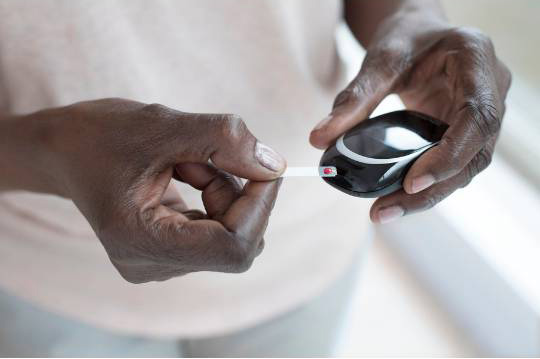
Highlighting the prevalence of diabetes in The Bahamas and the poor diet choices some Bahamians make, Drs. Ariane Davis-Simmons and Janette Martin, of Doctors Hospital, said many diabetics suffer from “portion distortion”.
The women, who were guests on Guardian Radio Show “Z-Live: Off The Record” with host Zhivargo Laing, recommend that Bahamians take practical steps to adjust their diet and exercise.
 “We know that exercise is good for cardiovascular health,” said Davis-Simmons, an endocrinologist. “So, the issue is that, unfortunately as a nation, we are eating more and exercising less.
“We know that exercise is good for cardiovascular health,” said Davis-Simmons, an endocrinologist. “So, the issue is that, unfortunately as a nation, we are eating more and exercising less.
“It comes back to the saying ‘a little bit of what you like goes a long way’. Don’t fall into portion distortion. So, reduce the amount you’re eating. You can have the starch. I’m not saying don’t have it, but limit it. I usually tell people to use a measuring cup and depending on where they are in obesity, where their BMI is, use half of a cup, no more than a cup. So, you measure it and when it’s done, it’s done. We all tend to eat more than we think we do.
“So, it’s portion distortion. When it’s done, it’s done.”
Dr. Martin, director of Weight Loss and Chronic Disease and Diabetes Education at Doctor Hospital Health System, said for those who don’t have a measuring cup, they can gauge the portion size by using the palm of their hand.
Diabetes is a chronic disease that affects how a person’s body turns food into energy. There are three main types of diabetes: type 1, type 2, and gestational diabetes (diabetes while pregnant).
In The Bahamas, there are approximately 46,400 or 11.6 percent of the population living with diabetes, and an additional 27,200 or 6.8 percent with prediabetes, according to podiatrist Dr. Monique Mitchell.
“The 2019 STEPS survey also tells us that most, or 55.3 percent of persons diagnosed with diabetes, do not take their medication regularly. This is of grave concern because we know uncontrolled diabetes often results in devastating complications, such as blindness, kidney failure, amputations and early death.”
Dr. Martin also stressed the importance of a healthy diet, noting that a lot of Bahamians suffer from food addictions.
“It takes a while to break a habit that you’ve been practicing for a very long time, and for most of us, we’ve been practicing these behaviors since childhood,” she said.
“It begins within the home. It’s a social and cultural issue that we deal with.”
Dr. Martin underscored the importance of slowly weening people from making bad food choices. She said this way, they are more likely to be consistent.
“With the habits for both adults and children, we do a progressive reduction of what they’re eating,” she said.
“And then you look at food combinations. For instance, you like your rice – a serving size of rice is about a third of a cup.
“Not all of the time you’re going to walk with your measuring cup. So, we tell you to use your palm. I tell people to open their hands and eyeball it. Make sure it’s less than the size of your palm, and that’s a third of a cup.
“So, you have to be practical when you’re changing behaviors and when you’re applying new changes, because if you go full speed ahead the person may practice it for 24 to 48 hours and then chuck it.”
She said a full-scale diet change is impractical.
“Not only that, the types of food that they were eating have now caused a food addiction. … If they want it, and they pass the restaurant, they clue into that. It’s like a drug addict, if he or she goes back in the neighborhood and mingle with the same friends, they’re gonna want it.”
The doctors recommend a larger serving of vegetables.
Dr. Martin added that it’s also impractical to use the traditional food pyramid for some Bahamians, as they don’t identify with it.
She said she uses a Bahamian drum instead of a food pyramid, and lists all the foods that Bahamians eat.
“If they could identify that with what we eat, it’s more practical for them,” she continued. “But if I give them a food pyramid and ask them to eat some quinoa, what is that to them?
“All these practical changes they have to be step by step,” she added, comparing the process to weening a baby off milk.
Dr. Davis-Simmons said in addition to implementing a healthy diet, Bahamians should exercise more.
“Exercise plays a big role in lowering the blood sugar,” she noted. “We know that even hours after exercise, cardiovascular exercise, the muscle takes up the sugar. So, it can lower blood sugar over the subsequent hours. It’s very important.
“We know exercise is important in creating a calorie deficit, so that you can help you to lose weight. We know that exercise is good for cardiovascular health. So the issue is that unfortunately as a nation, we are eating more and exercising less.”
She added that monitoring diabetes is the cornerstone of care.
Dr. Davis-Simmons recommends that patients on insulin check their blood sugar about three times a day, while those on medication check their blood sugar level about once a day.
She said this helps with behavior modification and to achieve good diabetes control.
 Signs and symptoms
Signs and symptoms
Signs and symptoms of diabetes include urinating a lot, often at night; being very thirsty, losing weight without trying, being very hungry, blurry vision, numb or tingling hands or feet, tiredness, dry skin, sores that heal slowly, and having more infections than usual, according to the Centers for Disease Control (CDC).
People who have type 1 diabetes may also have nausea, vomiting or stomach pains. Type 1 diabetes can be diagnosed at any age, and symptoms can develop in just a few weeks or months and can be severe.
Type 2 diabetes symptoms often take several years to develop and usually start in adulthood, though more children and teens are developing it.
Gestational diabetes (diabetes during pregnancy) usually doesn’t have any symptoms. Pregnant women should be tested for gestational diabetes between 24 and 28 weeks of pregnancy.
Risk factors
Risk factors for type 1 diabetes are not as clear as for pre-diabetes and type 2 diabetes, according to the CDC. Known risk factors include family history – having a parent, brother, or sister with type 1 diabetes, and age. The CDC currently says no one knows how to prevent type 1 diabetes.
You are at risk for type 2 diabetes if you have prediabetes, are overweight, 45 years or older, have a parent, brother, or sister with type 2 diabetes, are physically active less than three times a week, have ever had gestational diabetes (during pregnancy) or given birth to a baby who weighed over nine pounds, or if you are an African American, Hispanic or Latino, American Indian or Alaska Native person. Some Pacific Islanders and Asian American people are also at higher risk. A person with non-alcoholic fatty liver disease may also be at risk for type 2 diabetes. Type 2 diabetes can be prevented or delayed with proven lifestyle changes, which include losing weight if overweight, eating a healthy diet, and getting regular physical activity.
You are at risk for prediabetes if you are overweight, 45 years or older, have a parent, brother, or sister with type 2 diabetes; are physically active less than three times a week, had gestational diabetes or given birth to a baby who weighed over nine pounds, are an African America, Hispanic or Latino, American Indian or Alaska Native person. Some Pacific Islanders and Asian American people are also at higher risk. Prediabetes can be prevented or reversed with proven lifestyle changes which include losing weight if overweight, eating a healthy diet, and getting regular physical activity.
You’re at risk for gestational diabetes if you had gestational diabetes during a previous pregnancy, given birth to a baby weighing over nine pounds, are overweight, are more than 25 years old, have a family history of type 2 diabetes, have a hormone disorder called polycystic ovary syndrome (PCOS), are an African American, Hispanic or Latino, American Indian, Alaska native, Native Hawaiian, or Pacific Islander person. Gestational diabetes usually goes away after a female gives birth, but increases their risk for type 2 diabetes; their baby is more likely to have obesity as a child or teen, and to develop type 2 diabetes later in life. The CDC says before a woman becomes pregnant, she may be able to prevent gestational diabetes with lifestyle changes which include losing weight if overweight, eating a healthy diet, and getting regular physical activity.
By Krystel Brown
The Nassau Guardian
Published: November 28, 2023
